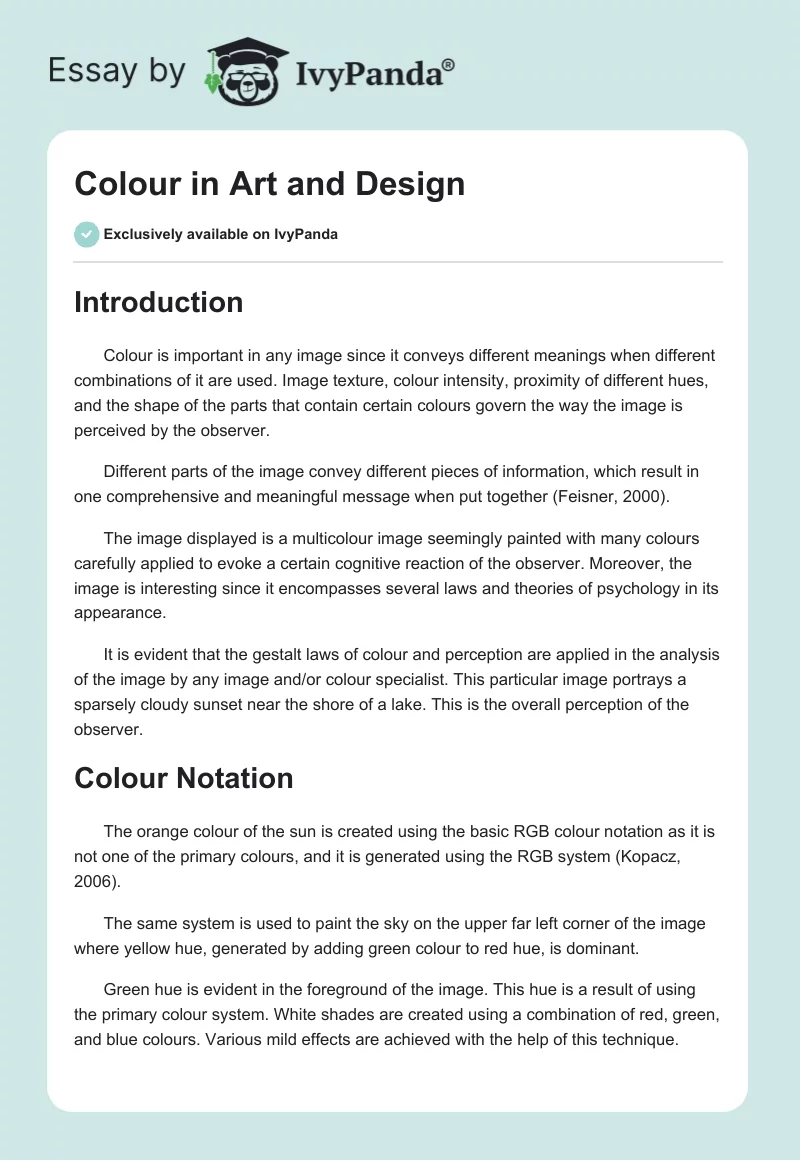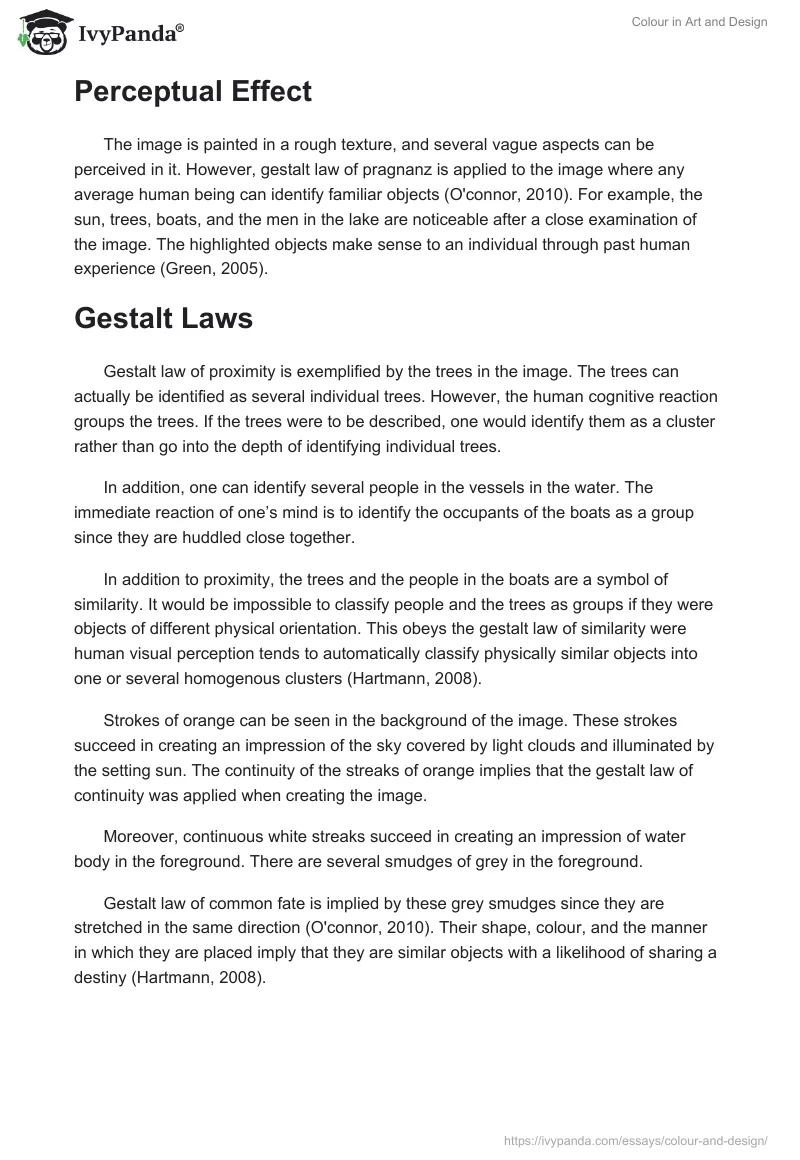Introduction
Colour is important in any image since it conveys different meanings when different combinations of it are used. Image texture, colour intensity, proximity of different hues, and the shape of the parts that contain certain colours govern the way the image is perceived by the observer.
Different parts of the image convey different pieces of information, which result in one comprehensive and meaningful message when put together (Feisner, 2000).
The image displayed is a multicolour image seemingly painted with many colours carefully applied to evoke a certain cognitive reaction of the observer. Moreover, the image is interesting since it encompasses several laws and theories of psychology in its appearance.
It is evident that the gestalt laws of colour and perception are applied in the analysis of the image by any image and/or colour specialist. This particular image portrays a sparsely cloudy sunset near the shore of a lake. This is the overall perception of the observer.
Colour Notation
The orange colour of the sun is created using the basic RGB colour notation as it is not one of the primary colours, and it is generated using the RGB system (Kopacz, 2006).
The same system is used to paint the sky on the upper far left corner of the image where yellow hue, generated by adding green colour to red hue, is dominant.
Green hue is evident in the foreground of the image. This hue is a result of using the primary colour system. White shades are created using a combination of red, green, and blue colours. Various mild effects are achieved with the help of this technique.
Perceptual Effect
The image is painted in a rough texture, and several vague aspects can be perceived in it. However, gestalt law of pragnanz is applied to the image where any average human being can identify familiar objects (O’connor, 2010). For example, the sun, trees, boats, and the men in the lake are noticeable after a close examination of the image. The highlighted objects make sense to an individual through past human experience (Green, 2005).
Gestalt Laws
Gestalt law of proximity is exemplified by the trees in the image. The trees can actually be identified as several individual trees. However, the human cognitive reaction groups the trees. If the trees were to be described, one would identify them as a cluster rather than go into the depth of identifying individual trees.
In addition, one can identify several people in the vessels in the water. The immediate reaction of one’s mind is to identify the occupants of the boats as a group since they are huddled close together.
In addition to proximity, the trees and the people in the boats are a symbol of similarity. It would be impossible to classify people and the trees as groups if they were objects of different physical orientation. This obeys the gestalt law of similarity were human visual perception tends to automatically classify physically similar objects into one or several homogenous clusters (Hartmann, 2008).
Strokes of orange can be seen in the background of the image. These strokes succeed in creating an impression of the sky covered by light clouds and illuminated by the setting sun. The continuity of the streaks of orange implies that the gestalt law of continuity was applied when creating the image.
Moreover, continuous white streaks succeed in creating an impression of water body in the foreground. There are several smudges of grey in the foreground.
Gestalt law of common fate is implied by these grey smudges since they are stretched in the same direction (O’connor, 2010). Their shape, colour, and the manner in which they are placed imply that they are similar objects with a likelihood of sharing a destiny (Hartmann, 2008).
Role of Contrast
Contrast plays a great role in conveying the information in the image. This phenomenon occurs due to a slightly noticeable difference in hues (Maund, 2006). An impression of the sun has been created in the background of the picture against a dull cloud. The fact that shades of grey and blue surround the orange hue makes the intensity of the sun stand out.
Reduced contrast between the impression of the illumination of the sky and the surrounding mixture of colours is the cause of this effect (O’connor, 2010). In addition, the use of orange in parts of the painting other than the sun creates an impression of vibrancy due to the effect of complimentary colours (Kuehni, 2007).
A silhouette of the water vessels and the people in them succeeds in creating an image that can be perceived by the human eye. Moreover, the sharp contrast in the image helps create a definite outline of the figures. The hue created by cyan and grey in the background results in warm and cold contrast with the intense orange colour of the sun.
Conclusion
Through the use of colours and a coarse painting technique, a multifaceted impression is made by the image. The creator of the image has also perfected the art of prioritisation of colours in their suitable context. For example, orange, a radiant colour, has been used when putting the sun against cyan and grey which are cool and dull hues respectively.
References
Feisner, E. (2000). Colour: how to use colour in art and design. London: Laurence King.
Green, P. (2005). The Value of Knowledge for Color Design. Perth: Curtin University.
Hartmann, G. (2008). Gestalt psychology: a survey of facts and principles. Whitefish, Mont.: Kessinger Pub..
Kopacz, J. (2006). Color in three-dimensional design. New York: McGraw-Hill.
Kuehni, R. (2007). Development of the Idea of the Idea of simple colors in the 16th and Early 17th centuries. Oxford: Wiley.
Maund, B. (2006). The Illusory of Colours. Washington: Universty of Washington press.
O’connor, Z. (2010). Colour Harmony Revisited. Colour Research and Application, 35(4), 267-273.


